Blog
Items filtered by date: September 2025
Managing Blisters on the Legs and Feet
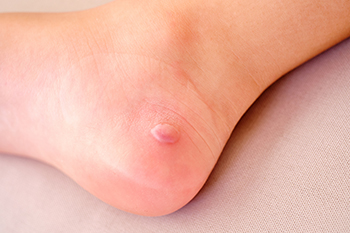
Blisters on the legs and feet are common and often result from friction, wearing poorly fitting shoes, or prolonged activity. These fluid-filled pockets form as the body’s way of protecting deeper layers of skin from further damage. While most blisters are small and heal on their own, they can be painful and interfere with walking or daily activities. It is best not to pop a blister, as this increases the risk of infection. Instead, keep the area clean and cover it with a sterile dressing or blister pad to reduce friction. If a blister does break, gently cleanse it and apply an antibiotic ointment before re-covering with a bandage. Individuals with diabetes or circulation problems should be especially cautious, since even minor blisters can lead to complications. It is suggested that you see a wound care specialist for guidance and treatment when needed.
Why Blisters Can Be Risky for Leg and Foot Health
Blisters are small pockets of fluid that form beneath the skin, often as a result of friction, pressure, or burns. On the feet, ankles, and legs, they are particularly common because these areas endure daily stress from walking, running, and wearing shoes. While many blisters are minor, they can become serious if not treated correctly, especially in individuals with diabetes or poor circulation.
Friction is the most common cause of blisters. Shoes that are too tight, too loose, or not properly cushioned may rub against the heel, toes, or sides of the foot, leading to painful fluid-filled bubbles. Activities such as hiking, sports, or even long periods of standing can also trigger blisters, especially when combined with moisture from sweat.
Other blisters may form from burns, allergic reactions, or underlying medical conditions. On the lower extremities, blisters that break open expose the skin to bacteria, increasing the risk of infection and complicating the healing process. If a blister appears on the ankle, heel, or shin, it may interfere with walking and daily mobility.
Proper care begins with protecting the blister. Keeping the area clean, covered, and free from further friction supports healing. However, large, painful, or recurrent blisters often require professional evaluation. For patients with compromised circulation or nerve damage, even a small blister can turn into a much larger problem if ignored.
A wound care specialist can determine the cause, provide safe drainage if needed, and apply advanced dressings to promote recovery. They can also recommend changes in footwear, activity, or skin protection strategies to prevent future blisters.
If you have developed a blister on your foot, ankle, or leg that is not healing or is becoming more painful, make an appointment with us as soon as possible.
Understanding Chronic Wounds on Legs and Feet
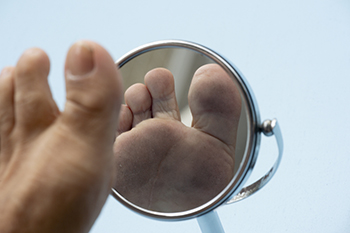
Chronic wounds on the legs and feet are injuries that fail to heal within a normal timeframe, often lasting weeks or even months. They may result from underlying health issues such as diabetes, poor circulation, venous disease, or repeated pressure on the same area. Common examples include diabetic ulcers, arterial ulcers, venous ulcers, and pressure injuries. These wounds can become painful, prone to infection, and may significantly impact daily activities if not properly managed. Effective treatment begins with identifying the root cause. This may involve improving circulation, relieving pressure with supportive footwear or dressings, and maintaining strict infection control. Specialized wound care products, debridement, or advanced therapies may also be recommended to encourage healing. Because chronic wounds rarely improve with home care alone, it is suggested that you see a wound care specialist for a thorough assessment and a personalized treatment plan.
Chronic Wounds and Complications That Slow Recovery
Most wounds follow a predictable healing pattern, but some linger far longer than expected. Chronic wounds are those that fail to progress through normal healing, often remaining open, painful, and vulnerable to infection. On the feet, ankles, and legs, these stubborn wounds can significantly limit mobility and quality of life.
Post-surgical wounds are a common source of concern. While surgery is intended to improve health, the incision site does not always close as planned. Compromised circulation, infection, or pressure can delay healing and leave patients dealing with ongoing discomfort. Professional monitoring and care are essential to ensure the wound is cleaned, dressed, and supported until closure is achieved.
Chronic pain conditions may also complicate recovery. Neuromas, for example, are thickened nerve tissues that can cause persistent pain in the foot. Although not open wounds themselves, they often interfere with normal gait and create pressure points that make the skin more prone to breakdown. Left unaddressed, this discomfort can contribute to recurring sores or prevent existing wounds from closing.
Chronic wounds require specialized attention because traditional home remedies are rarely enough. Advanced wound care techniques may involve debridement, specialized dressings, pressure offloading, or therapies designed to improve blood flow and tissue repair.
If you have a wound on your foot, ankle, or leg that is not healing or continues to reopen, call us today for expert care from our wound specialist.
Caring for Cuts and Abrasions on the Lower Limbs
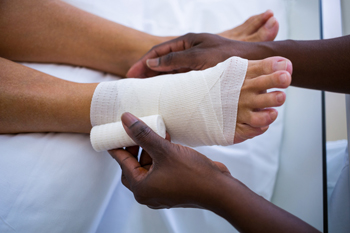
Cuts and abrasions on the lower limbs are common injuries that may seem minor but can become serious, if not treated correctly. The skin on the legs and feet is often exposed and may heal more slowly due to reduced circulation, especially in individuals with diabetes or vascular conditions. Even small wounds can turn into chronic problems, if neglected. Proper care begins with gentle cleansing to remove dirt and bacteria, followed by applying a clean dressing to protect the area. Monitoring for signs of infection, such as redness, swelling, or discharge, is essential. Wearing supportive footwear and avoiding friction helps prevent worsening of abrasions. Because lower limb wounds can be complicated by underlying health issues, it is suggested that you see a wound care specialist for a professional evaluation and the most effective treatment plan.
Wounds on the feet, ankles, and legs require special attention because these areas are extremely vulnerable to infection and slower healing. Even a small scrape or cut can become more serious if not treated promptly, particularly for individuals with diabetes, poor circulation, or weakened immune systems.
Abrasions occur when the skin is rubbed or scraped against a rough surface, often leaving raw, painful patches that expose delicate tissue. On the feet and legs, these are more susceptible to contamination from shoes, socks, and daily activities. Cuts and scrapes that break through deeper layers of the skin create open wounds that may bleed and require proper cleaning and covering to reduce risk of infection.
Some injuries are more complex. Traumatic wounds, such as lacerations caused by accidents or falls, can damage not only the skin but also the underlying structures of the foot or ankle. Puncture wounds from sharp objects are another concern, as they are often narrow and deep, allowing bacteria to become trapped inside. These injuries may not look severe on the surface, but can result in serious infection if not evaluated by a wound specialist.
Because the lower extremities play such a vital role in mobility, untreated wounds in this region can interfere with daily activities, and, in severe cases, threaten long-term health. Proper wound care includes cleaning, dressing, and monitoring the injury, and in some cases, advanced treatment to close or debride the wound and support faster healing.
If you have a cut, abrasion, or puncture wound on your foot, ankle, or leg that is not improving or appears infected, call us for help today. Prompt treatment ensures effective healing and helps protect your mobility and overall health.
When Foot Wounds Refuse to Heal
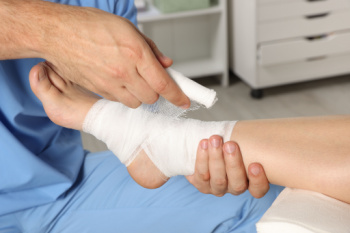
Some foot wounds close within days, but others linger for weeks or even months, becoming a chronic problem. These slow-healing injuries often develop in people with poor circulation, nerve damage, or conditions like diabetes that impair the body’s repair process. Persistent pressure from walking, wearing tight shoes, or foot deformities can keep the skin from closing properly, while unnoticed infections may worsen the damage. Over time, a chronic wound can extend deeper into tissue, raising the risk of serious complications, including bone infection. Because sensation in the feet may be reduced, pain is not always a reliable warning sign. Regular inspection, professional wound care, and addressing the underlying cause are critical for recovery. If a foot sore does not show signs of improvement within a reasonable time, it is suggested that you see a podiatrist for prompt evaluation and treatment.
Wound care is an important part in dealing with diabetes. If you have diabetes and a foot wound or would like more information about wound care for diabetics, consult with one of our podiatrists" from Practice. Our practitioners will assess your condition and provide you with quality foot and ankle treatment.
What Is Wound Care?
Wound care is the practice of taking proper care of a wound. This can range from the smallest to the largest of wounds. While everyone can benefit from proper wound care, it is much more important for diabetics. Diabetics often suffer from poor blood circulation which causes wounds to heal much slower than they would in a non-diabetic.
What Is the Importance of Wound Care?
While it may not seem apparent with small ulcers on the foot, for diabetics, any size ulcer can become infected. Diabetics often also suffer from neuropathy, or nerve loss. This means they might not even feel when they have an ulcer on their foot. If the wound becomes severely infected, amputation may be necessary. Therefore, it is of the upmost importance to properly care for any and all foot wounds.
How to Care for Wounds
The best way to care for foot wounds is to prevent them. For diabetics, this means daily inspections of the feet for any signs of abnormalities or ulcers. It is also recommended to see a podiatrist several times a year for a foot inspection. If you do have an ulcer, run the wound under water to clear dirt from the wound; then apply antibiotic ointment to the wound and cover with a bandage. Bandages should be changed daily and keeping pressure off the wound is smart. It is advised to see a podiatrist, who can keep an eye on it.
If you have any questions please contact our office located in Contact Us . We offer the newest diagnostic and treatment technologies for all your foot and ankle needs.
Taking an Active Role in Your Ostomy Care
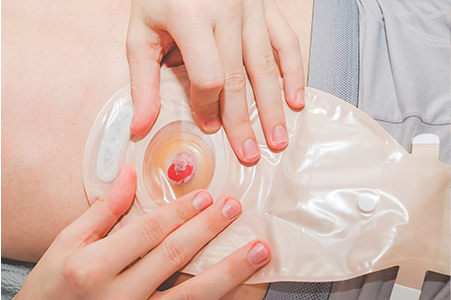
Patient involvement in ostomy care plays a key role in recovery, independence, and long-term well-being. From the early days after surgery, patients are encouraged to participate in pouch changes and skin care under the guidance of an ostomy specialist. This hands-on approach builds confidence, helps patients recognize early signs of complications, and promotes better self-management. Learning how to properly clean the stoma, select and fit pouching systems, and manage output allows patients to adapt more easily to daily life. Involvement also extends to understanding dietary needs, fluid intake, and lifestyle adjustments that support stoma health. Emotional readiness is equally important, as active participation often helps patients feel more in control and less dependent on others. For personalized training and support to help you take an active role in your care, it is suggested that you work closely with an ostomy specialist.
Ostomy Care and Support Services
Living with an ostomy can feel overwhelming, but with the right care and guidance, patients can regain comfort, confidence, and control in their lives. Our practice is dedicated to supporting individuals at every stage of their ostomy journey. Whether the surgery is new or long behind you, our specialists focus on helping you adapt comfortably and address any challenges that arise.
An ostomy is a surgically created opening that allows waste to leave the body through the abdomen. This can be necessary after certain medical conditions or surgeries involving the digestive or urinary system. Colostomy, ileostomy, and urostomy are common types of ostomies. Each requires specific care and attention, and our experienced team is skilled in managing all types.
Our specialist provides personalized care plans, beginning with detailed education on how to care for your stoma, or opening to the waste system, managing your pouching system, and protecting the surrounding skin. We also offer troubleshooting assistance for common issues such as leakage, skin irritation, and improper fit of appliances. Helping you achieve a secure and comfortable fit is one of our top priorities, as it can significantly impact your quality of life.
In addition to hands-on care, we believe education is empowering. Our team takes time to explain changes to your body, guide you through product options, and address emotional concerns with compassion. We understand that living with an ostomy is not only a physical adjustment but also an emotional one, and we are here to provide both clinical and personal support.
We work closely with your other possible healthcare providers to ensure seamless coordination of your care. From helping with pouching supplies to teaching skin protection techniques, our team is committed to helping you feel more at ease in your daily life.
Learn more about this procedure today. Our caring specialists are ready to help you navigate this journey with confidence and dignity.
What complications can occur with an ostomy?
Skin irritation, leakage, and stoma blockage are common concerns that may require medical attention or changes in pouching techniques.
Can you live a normal life with an ostomy?
Most people return to work, exercise, and travel after surgery, although adjustments in diet and pouch management are often necessary.
If you have any questions, please feel free to contact our office located in Contact Us . We offer the newest diagnostic and treatment technologies for all your foot care needs.
